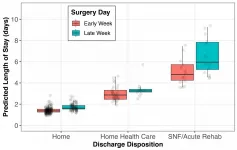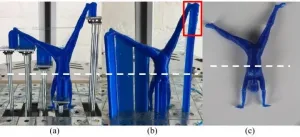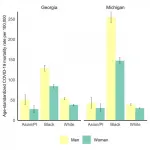(Press-News.org) CHARLOTTESVILLE, VA (APRIL 6, 2021). New research by a team from the Cleveland Clinic and the London School of Economics and Political Science (LSE) has determined that surgeries performed late in the workweek, and those culminating in discharge to a specialty care facility, are associated with higher costs and unnecessarily longer stays in the hospital following a common elective spine surgery.
Sebastian Salas-Vega, PhD, and colleagues retrospectively reviewed the data for all adult patients who underwent elective lumbar laminectomy over a nearly three-year period at any Ohio hospital included within the Cleveland Clinic system. The laminectomies were performed for degenerative stenosis of the lower spine and included both open and minimally invasive procedures. The surgeries were performed to release pressure on spinal nerves at one or more sites in the lumbar spine, reducing patients' pain and improving their neurological function.
Following surgery, recuperation in the hospital over several days can be very expensive and, in some cases, unnecessary. In efforts to curb expenses, shortening the hospital length of stay is paramount--as long as it is clinically justified and does not negatively impact patient outcomes.
The authors' goal in this study was to distinguish between clinical and nonclinical factors that drive the length of a patient's stay in the hospital for this common spine procedure and to understand the relationships between these factors and both patient outcomes and hospital costs. The findings can be found in a new article, "Late-week surgery and discharge to specialty care associated with higher costs and longer lengths of stay after elective lumbar laminectomy," published today in the Journal of Neurosurgery: Spine.
Using generalized linear modeling, the researchers assessed relationships between the day of the week when surgery was performed and the length of hospital stay (LOS) and patient discharge to specialized care, while making adjustments for underlying patient health risks and other non-clinical factors, including health insurance and the facility where the surgery was performed.
The researchers found that patients' mean LOS varied according to what day of the workweek the surgery was performed: 2.01 days on Monday, 2.04 days on Tuesday, 2.16 days on Wednesday, 2.64 days on Thursday, and 2.47 days on Friday. For patients treated on Thursdays or Fridays, the mean LOS was approximately 20% to 30% longer than that for patients treated on Mondays or Tuesdays.
The association between surgery performed late in the week (Thursday or Friday) and a prolonged LOS was apparent regardless of the extent of patients' comorbidities or the occurrence of postoperative complications. These findings also "persisted even after adjusting for patient demographics, ... hospital surgery site, and insurance."
The paper reveals that total costs of care also vary according to when surgery is performed, with surgical costs being about 20% higher for patients who undergo surgery on Friday than for patients treated on Monday. Among patients who are later discharged to specialized care facilities, the costs are 24% higher for those treated late in the week than for those treated earlier. The trend for higher costs among patients treated late in the week is also observed across all health insurance groups (private/commercial, Medicare, Medicaid, and so forth), pointing to potential cost savings irrespective of insurer.
The researchers suggest that costs and lengths of hospital stay could be lowered by improving the surgical scheduling process and care coordination. They believe that predictive analytics could, for instance, assist in identifying which patients might be more likely to require specialty care after hospital discharge. Surgeries for those patients could then be scheduled earlier in the week, helping to avoid weekend discharge and resulting in shorter lengths of stay and lower costs to patients, insurers, and healthcare providers.
When asked about the findings of this study, Dr. Salas-Vega responded, "Without considering what care is delivered, our study suggests that changing how it is scheduled can help improve patients' surgical experience, reduce hospital lengths of stay, and lower costs. These findings remind us that even some of the more mundane aspects of patient care can significantly impact their hospital course. If the ambition for providers around the world is to deliver the highest quality care, optimizing surgical scheduling and care coordination may represent low-hanging fruit among efforts to reduce unnecessarily long postoperative stays."
INFORMATION:
Article: Salas-Vega, S, Chakravarthy VB, Winkelman RD, Grabowski MM, Habboub G, Savage JW, Steinmetz MP, Mroz TE. Late-week surgery and discharge to specialty care associated with higher costs and longer lengths of stay after elective lumbar laminectomy. J Neurosurg Spine, published ahead of print April 6, 2021. DOI: 10.3171/2020.11.SPINE201403.
Disclosure: Dr. Savage reports a consultant relationship with Stryker. Dr. Steinmetz reports a consultant relationship with Globus; receipt of speaker's fees from Zimmer Biomet, Globus, and Elsevier; and receipt of honoraria from Globus and Stryker. Dr. Mroz reports receipt of royalties from Stryker. Publication of this work was graciously supported by grants to Dr. Salas-Vega from the Sanford J. Larson Honor Your Mentor Fund and the Academy of Medicine Education Foundation.
For additional information, contact: Ms. Jo Ann M. Eliason, Communications Manager, JNS Publishing Group, One Morton Drive, Suite 200, Charlottesville, VA 22903; Email joanneliason@thejns.org; Phone 434-982-1209.
The Journal of Neurosurgery: Spine is a monthly peer-reviewed journal focused on neurosurgical approaches to treatment of diseases and disorders of the spine. It contains a variety of articles, including descriptions of preclinical and clinical research as well as case reports and technical notes. The Journal of Neurosurgery: Spine is one of six journals published by the JNS Publishing Group, the scholarly journal division of the American Association of Neurological Surgeons. Other peer-reviewed journals published by the JNS Publishing Group each month include Journal of Neurosurgery, Journal of Neurosurgery: Pediatrics, Journal of Neurosurgery: Case Lessons, Neurosurgical Focus, and Neurosurgical Focus: Video. All six journals can be accessed at http://www.thejns.org.
Founded in 1931 as the Harvey Cushing Society, the American Association of Neurological Surgeons (AANS) is a scientific and educational association with more than 10,000 members worldwide. The AANS is dedicated to advancing the specialty of neurological surgery in order to provide the highest quality of neurosurgical care to the public. All active members of the AANS are certified by the American Board of Neurological Surgery, the Royal College of Physicians and Surgeons (Neurosurgery) of Canada, or the Mexican Council of Neurological Surgery, AC. Neurological surgery is the medical specialty concerned with the prevention, diagnosis, treatment, and rehabilitation of disorders that affect the entire nervous system including the brain, spinal column, spinal cord, and peripheral nerves. For more information, visit http://www.AANS.org.
Newer is not always better; a study in CMAJ (Canadian Medical Association Journal) led by researchers at the University of Warwick shows that simple fetal heartbeat monitoring is still the best method for determining whether a baby is in distress during delivery and whether cesarean delivery is needed http://www.cmaj.ca/lookup/doi/10.1503/cmaj.202538.
Cesarean delivery is the most common surgical procedure worldwide, performed to expedite birth and avoid neonatal complications.
Listening to the fetal heart rate using a stethoscope -- intermittent auscultation -- has been used for years to assess the fetal state and whether the baby is experiencing distress that might require a cesarean delivery. Other monitoring techniques have become ...
Legalization of recreational cannabis may be associated with an increase in fatal motor vehicle collisions based on data from the United States, and authors discuss the implications for Canada in an analysis in CMAJ (Canadian Medical Association Journal).
"Analyses of data suggest that legalization of recreational cannabis in United States jurisdictions may be associated with a small but significant increase in fatal motor vehicle collisions and fatalities, which, if extrapolated to the Canadian context, could result in as many as 308 additional driving fatalities annually," says Ms. Sarah Windle, Lady Davis Institute/McGill ...
Hamilton, ON (April 6, 2021) - If you are one of the millions of people worldwide suffering from allergies, you may take an antihistamine pill to ward off hives, sneezing and watery eyes.
But you may be taking your medications incorrectly, says Derek Chu, a McMaster University allergy expert and clinical scholar.
"People need to rethink what they stock in their home cabinets as allergy medicines, what hospitals keep on formulary, and what policymakers recommend. The message needs to get out. This publication is on time for the spring allergy season and as COVID vaccines roll out, for which rashes are common and antihistamines can be helpful," said Chu.
Co-author Gordon ...
The idea of implantable sensors that continuously transmit information on vital values and concentrations of substances or drugs in the body has fascinated physicians and scientists for a long time. Such sensors enable the constant monitoring of disease progression and therapeutic success. However, until now implantable sensors have not been suitable to remain in the body permanently but had to be replaced after a few days or weeks. On the one hand, there is the problem of implant rejection because the body recognizes the sensor as a foreign object. On the other hand, the sensor's color which indicates concentration changes has been unstable so far and faded over time. Scientists at Johannes Gutenberg University Mainz (JGU) have developed a novel type of implantable sensor which can ...
In 2001, the famous herpetologist Joseph B. Slowinski died from snakebite by an immature black-and-white banded krait, while leading an expedition team in northern Myanmar. The very krait that caused his death is now confirmed to belong to the same species identified as a new to science venomous snake, following an examination of samples collected between 2016 and 2019 from Yingjiang County, Yunnan Province, China.
The new krait species, found in Southwestern China and Northern Myanmar, is described by Dr Zening Chen of END ...
A new study analyzing bean production and food security across 11 countries in sub-Saharan Africa, found COVID-19 pandemic-related restrictions to significantly impact bean production. Border controls and high transport costs have led to drops in production of the key food security crop, threatening to reverse gains made in achieving Sustainable Development Goals 1 and 2, towards no poverty and zero hunger, respectively.
Even before the pandemic, 55% of the world's hungry people and 70% of the world's poorest people lived in Africa, the researchers said. In addition, food systems across Africa were already affected by the adverse impacts of climate change, disease and pests, such as the worst desert locust outbreak in 70 years impacting food security in Kenya, Somalia, ...
3-D printing has the potential to revolutionize product design and manufacturing in a vast range of fields--from custom components for consumer products, to 3-D printed dental products and bone and medical implants that could save lives. However, the process also creates a large amount of expensive and unsustainable waste and takes a long time, making it difficult for 3-D printing to be implemented on a wide scale.
Each time a 3-D printer produces custom objects, especially unusually-shaped products, it also needs to print supports-printed stands that balance the object as the printer creates layer by layer, ...
Likely the first extinction event of the 2000s in Europe, the sad history of the Pyrenean Ibex (Capra pyrenaica pyrenaica) is a powerful example of the ever-increasing species loss worldwide due to causes related to human activity. It can, however, give us valuable information on what should be done (or avoided) to halt this extinction vortex.
The distribution of this subspecies of Iberian Ibex was limited to the French and Spanish Pyrenees. Its first mention in an official written document, dating back to 1767, already refers to it as extremely rare. Like many other mountain goats, it was almost hunted to extinction before its killing became prohibited in 1913. Neither the institution ...
Insomnia is a common problem in patients with schizophrenia, and a new study reinforces a close association between insomnia, more suicidal thoughts and actions and increased problems like anxiety and depression in these patients.
It also provides more evidence that keeping tabs on how patients are sleeping -- and intervening when needed -- is important to their overall care.
"We are now aware that significant insomnia is putting our patients at even higher risk for suicide, so if they are having changes in sleep patterns, if they are having significant insomnia, then we really need to hone in on those questions even more related to suicidal thinking and do what we can to help," says Dr. ...
A new paper in the Journal of General Internal Medicine published by the GenderSci Lab at Harvard University shows that Black women are dying at significantly higher rates than white men, and that disparities in mortality rates among women of all races are greater than those between white women and white men.
The study is the first to quantify the inequities in COVID-19 mortality looking at both race and sex group.
"This analysis complicates the simple narrative that men are dying at greater rates of COVID-19 than women," said lead author Tamara Rushovich, Harvard Ph.D. candidate in population health sciences and lab member ...







